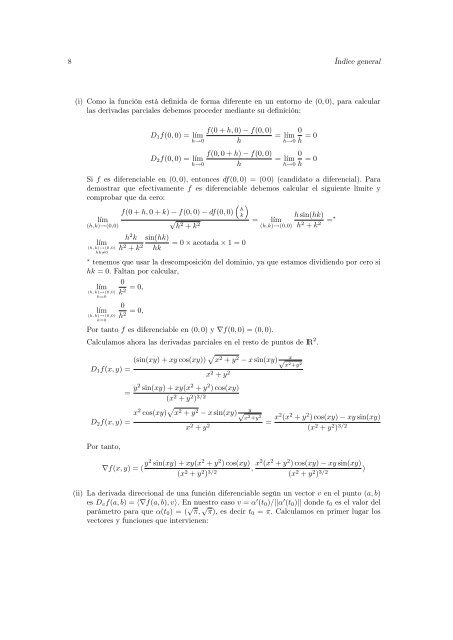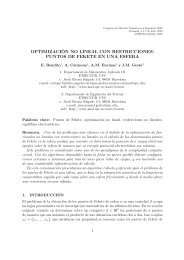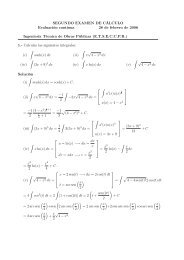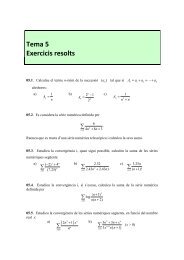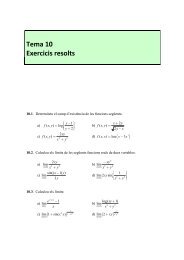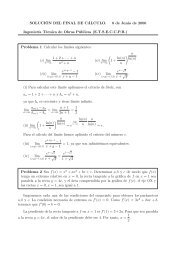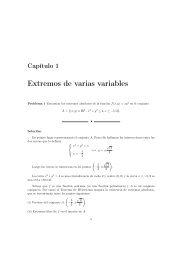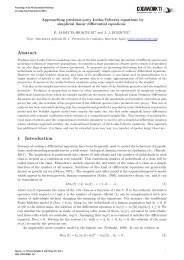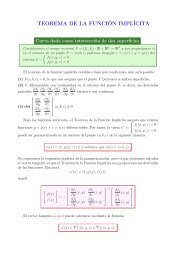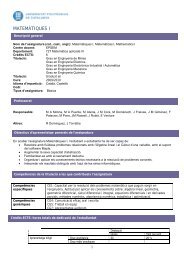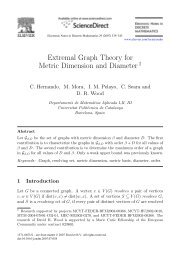Problemas de diferenciabilidad y geométricos
Problemas de diferenciabilidad y geométricos
Problemas de diferenciabilidad y geométricos
Create successful ePaper yourself
Turn your PDF publications into a flip-book with our unique Google optimized e-Paper software.
8 Índice general<br />
(i) Como la función está <strong>de</strong>finida <strong>de</strong> forma diferente en un entorno <strong>de</strong> (0, 0), para calcular<br />
las <strong>de</strong>rivadas parciales <strong>de</strong>bemos proce<strong>de</strong>r mediante su <strong>de</strong>finición:<br />
f(0 + h, 0) − f(0, 0) 0<br />
D 1 f(0, 0) = lím<br />
= lím<br />
h→0 h<br />
h→0 h = 0<br />
f(0, 0 + h) − f(0, 0) 0<br />
D 2 f(0, 0) = lím<br />
= lím<br />
h→0 h<br />
h→0 h = 0<br />
Si f es diferenciable en (0, 0), entonces df(0, 0) = (0 0) (candidato a diferencial). Para<br />
<strong>de</strong>mostrar que efectivamente f es diferenciable <strong>de</strong>bemos calcular el siguiente límite y<br />
comprobar que da cero:<br />
)<br />
lím<br />
(h,k)→(0,0)<br />
lím<br />
(h,k)→(0,0)<br />
hk≠0<br />
f(0 + h, 0 + k) − f(0, 0) − df(0, 0)<br />
(<br />
h<br />
k<br />
√<br />
h2 + k 2 = lím<br />
(h,k)→(0,0)<br />
h 2 k sin(hk)<br />
h 2 + k 2 = 0 × acotada × 1 = 0<br />
hk<br />
h sin(hk)<br />
h 2 + k 2 =∗<br />
∗ tenemos que usar la <strong>de</strong>scomposición <strong>de</strong>l dominio, ya que estamos dividiendo por cero si<br />
hk = 0. Faltan por calcular,<br />
0<br />
k 2 = 0,<br />
lím<br />
(h,k)→(0,0)<br />
h=0<br />
lím<br />
(h,k)→(0,0)<br />
k=0<br />
0<br />
h 2 = 0,<br />
Por tanto f es diferenciable en (0, 0) y ∇f(0, 0) = (0, 0).<br />
Calculamos ahora las <strong>de</strong>rivadas parciales en el resto <strong>de</strong> puntos <strong>de</strong> IR 2 .<br />
(sin(xy) + xy cos(xy)) √ x 2 + y 2 − x sin(xy)<br />
D 1 f(x, y) =<br />
x 2 + y 2<br />
= y2 sin(xy) + xy(x 2 + y 2 ) cos(xy)<br />
(x 2 + y 2 ) 3/2<br />
x 2 cos(xy) √ x 2 + y 2 − x sin(xy)<br />
D 2 f(x, y) =<br />
x 2 + y 2<br />
Por tanto,<br />
√<br />
y<br />
x2 +y 2<br />
√<br />
x<br />
x2 +y 2<br />
= x2 (x 2 + y 2 ) cos(xy) − xy sin(xy)<br />
(x 2 + y 2 ) 3/2<br />
∇f(x, y) = ( y2 sin(xy) + xy(x 2 + y 2 ) cos(xy)<br />
(x 2 + y 2 ) 3/2 , x2 (x 2 + y 2 ) cos(xy) − xy sin(xy)<br />
(x 2 + y 2 ) 3/2 )<br />
(ii) La <strong>de</strong>rivada direccional <strong>de</strong> una función diferenciable según un vector v en el punto (a, b)<br />
es D v f(a, b) = 〈∇f(a, b), v〉. En nuestro caso v = α ′ (t 0 )/||α ′ (t 0 )|| don<strong>de</strong> t 0 es el valor <strong>de</strong>l<br />
parámetro para que α(t 0 ) = ( √ π, √ π), es <strong>de</strong>cir t 0 = π. Calculamos en primer lugar los<br />
vectores y funciones que intervienen:


